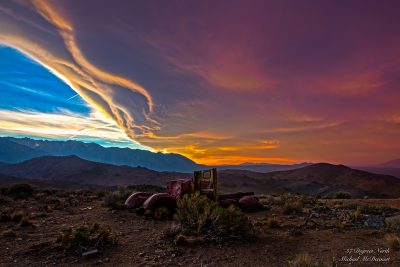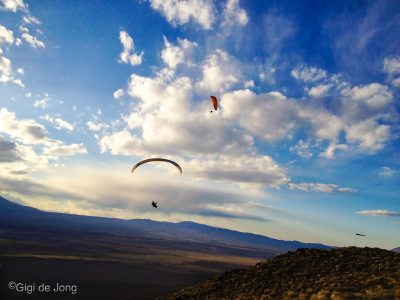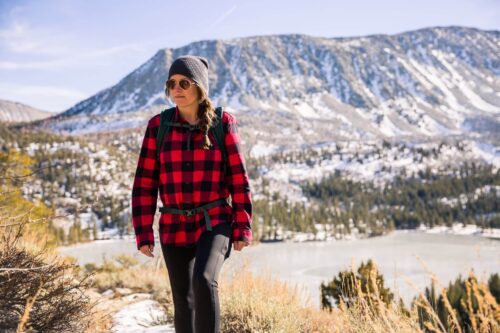Bishop by Air (Part 1)

“The desire to fly is an idea handed down to us by our ancestors who… looked enviously on the birds soaring freely through space… on the infinite highway of the air.” ~ Wilbur Wright
US Highway 395 is the route that most visitors drive to reach Bishop, but “the infinite highway of the air” is another, more spectacular and almost limitless, approach to Bishop. Flying above the Owens Valley is an experience that leaves an indelible impression on everyone who takes to the skies here. The magnificent topographic features that make Bishop so incredibly photogenic, also make Bishop a unique flying destination.
A Short History of Flying in the Owens Valley
Robert F. Symons
One of the earliest flying pioneers in the Owens Valley was Robert ‘Bob’ Symons. A Bishop born-and-bred local, Symons grew up on a ranch on land that was later to form part of the current Bishop Airport facility.

His interest in flying began while he was attending Riverside Junior College in the late 1920s when he had the opportunity to work on a glider project. This interest in aviation resulted in a failing grade at college and his father ordered him back to Bishop to work on the family ranch. In 1935 Bob married Mildred Wells, also a Bishop local, and a few months later he suffered a farming accident that resulted in the amputation of his right leg. Undaunted and after receiving a prosthetic leg he continued to work on the ranch. For the rest of his life, most people on meeting him were surprised to learn of his artificial limb. A few years later he and Mildred moved into Bishop and together built a home that had a room large enough to hold glider wings. He had recognized the soaring potential in the Owens Valley early on and in 1938 helped to organize a soaring expedition to the area. By 1939 Bob decided to devote himself to his passion for flying.
Despite being an amputee Bob secured a job at a glider shop in San Fernando and was able to obtain his pilot’s license. He went on to become an accredited trainer for military glider pilots and later worked on a large-scale military glider project. Through all these experiences, beginning with that first foray into building a glider airframe at Riverside College, Symons made and stayed friends with many of aviation’s early pioneers.

In 1946 Symons teamed up with Harland Ross to start a flying service out of Bishop from the soon-to-be ex-military airfield. For the next five years he and Ross spent innumerable hours flying over the valley and the Sierra Nevada and between them set numerous altitude flying records. It was during this time that they did serious flying experiments with powered planes and non-powered gliders and began to understand and appreciate the phenomenon that is now known as ‘Sierra Wave’, a term that was coined by Symons. Mountain wave (as it is now known in other mountainous regions of the world) was a little-known phenomenon at the time. Their experimentations gave rise to “The Sierra Wave Project” which was a groundbreaking study funded and conducted jointly by the US Navy, Air Force and UCLA.
The aviation boom that was expected after World War II did not materialize as expected, but that didn’t diminish Symons’ enthusiasm for flying and experimentation. He undertook a job with Cal Electric, which was one of the predecessors of what is now Southern California Edison, to do cloud seeding to increase snow- and rainfall in the company’s catchment area. Although they kept it under wraps for many years, it proved to be very successful. He also flew a great many search and rescue missions and transported people, goods and services into the backcountry of the Sierra Nevada for mining, hunting, trekking and research expeditions.
He continued to promote Bishop as a soaring destination and soaring competitions became a feature of the Bishop flying calendar. Sadly, in 1958 just a few months before Bishop was to host the National Soaring Championships, Symons lost his life in a glider accident at El Mirage, CA. On hearing of his death, the California Legislature passed a resolution mourning his death and adjourned early “out of respect to the memory of the late Bob Symons.”
Such was the legacy of this pioneering pilot of the Owens Valley.
Hang gliding and Paragliding
The early history of hang gliding dates back to the 1800s and is considered to be one of the oldest forms of human flight. Much of the early research and successes in gliding became the basis on which powered flight was developed and, as we know, resulted in the Wright brothers’ success at Kitty Hawk. Once powered flight had been achieved, the achievements of those early hang gliding pioneers were largely forgotten. Competitive gliding in sailplanes, non-powered aircraft with enclosed cockpits, developed as an aviation sport shortly after World War I and continues to be popular today.
It wasn’t until the 1960s that interest in hang gliding, where a pilot is suspended from a flexible, fixed wing, was revived when the general public was made aware of the creation and experimentation of the Rogallo Wing. This reinvented hang glider was the work of a NASA scientist, Dr. Francis Rogallo, and his wife. They began work on a hang glider design in their spare time and patented the design in 1948. This caught the interest of his employers at NASA, which had just entered the ‘space race’, and the organization conducted many tests during the 1950s using this flexible wing as a recovery ‘chute’ for their space capsules. When the images of this new flying wing were released to the public, aviation enthusiasts saw its potential for recreation and sport. And thus began the modern era of hang gliding.
By the 1970s hang gliders could fly higher, further, and in stronger wind conditions. The Owens Valley became the Mecca for this growing sport. Many world firsts and world records, such as time-in-the-air and distance covered, were set here. Some of these still stand. The sport as a whole continues to see growth and innovation, and in the mid-1980s the development of paragliding, where a pilot is harnessed beneath a parachute-style wing, opened up the sport to many more flying enthusiasts. Now thousands of pilots around the world participate for personal satisfaction and competitive goals.
With the advent of specialized tow planes to tow a pilot into the air, hang glider pilots have produced remarkable achievements in flatland flying. In the right conditions, a skilled pilot can cover many hundreds of miles in one, continuous unpowered flight. And yet, pilots still convene in Bishop to experience the thrill of big mountain foot launches and the promise of exceptional ‘lift’ created by this unique valley with its mountainous terrain on both sides of the hot, dry valley floor.
Bishop Airport
 The Bishop Army Airfield was opened in April 1940 to serve as a sub-base during World War II for use as a training and storage facility. It was built on land leased from Inyo County. In 1949, when the Army canceled its lease with Inyo County, the airport was placed under civil control. Between 1965 and 1985 the US Airforce (USAF) subleased runway rights intermittently for over 10 years and used the heliport area and runway for performance testing of helicopters and other aircraft.
The Bishop Army Airfield was opened in April 1940 to serve as a sub-base during World War II for use as a training and storage facility. It was built on land leased from Inyo County. In 1949, when the Army canceled its lease with Inyo County, the airport was placed under civil control. Between 1965 and 1985 the US Airforce (USAF) subleased runway rights intermittently for over 10 years and used the heliport area and runway for performance testing of helicopters and other aircraft.
In 2002 Bishop Airport was granted the distinction of National Landmark of Soaring for The Sierra Wave Project. The program was established in 1980 and the title of National Landmark of Soaring has only been granted 16 times to date.
Flying the Owens Valley Today
Bishop Airport Today
Today Bishop Airport (KBIH) is owned by the city of Los Angeles and is leased and maintained by Inyo County as a public airport for the region. The airport sees activity from a wide range of aviators and organizations. In addition to serving the local community of private pilots, the airport attracts business from visiting pilots and air charter companies. When needed it is a base for Inyo County Search & Rescue operations and firefighting tanker planes. Fire repellent is stored on-site during fire season. A commercial medical evacuation service is based permanently at the airport and is ‘on-call’ 24/7/365. Local, regional and national agencies such as the US Military, US Forest Service, CA Dept. of Fish & Wildlife, and utility companies use the airport as a base for refueling and aircraft storage.
Local aviation enthusiasts will often head out to the airport when unusual or interesting aircraft are seen overhead approaching the airport to land. (I do and I’ve seen a DC9, military and coast guard C130 aircraft, USAF Apache, Blackhawk, and Chinook Helicopters, the Sikorski Skycrane, and, one of my favorite sights, the V-22 Osprey.) The airport is located just 2-miles east of the town and it’s a quick drive to visit and make use of the services offered at the Bishop Airport.

It is optimally situated with three long runways offering six directions for safe take-off and landing. One runway is newly refurbished with all-new, state-of-the-art, pilot-activated, LED lights for night flights. There is no control tower and while the “open airspace” is generally uncrowded, pilot navigational aids are always fully operational for safe flying.
On the ground, the tie-downs are almost unlimited and fuel is very reasonably priced. The small airport building has all the necessary amenities, including a good Thai food restaurant that is well regarded by Bishop locals, and the staff is known to be helpful and friendly.
“We’re a small-town airport, with a small-town attitude,” says Ken Babione, the Airport Operations Supervisor, “We take care of the people who come here.”
V-22 Osprey from Gigi de Jong on Vimeo.
Bishop as Base
Bishop provides a unique opportunity from which to explore this region by air. A flight of about 1 hour in a light aircraft out of Bishop Airport will present an unforgettable experience and open up a window of wonder over some of the most beautiful sights that this region has to offer.
There is an aviation slang term, “The $100 hamburger,” that refers to a pilot’s excuse for a fun flight of about an hour or more to a destination to eat a burger and then fly home.
Local resident and private pilot, Wayne Sayer, says, “Bishop is a straight shot from the Los Angeles area.” And he adds humorously, “This makes it the perfect place for the $100 Pad Thai.”

Flying into Bishop can be so much more than just a quick jaunt. It can be the base from which to explore the vast and magnificent Eastern Sierra. Besides services offered for plane owners, Bishop Airport also has charter aircraft and sightseeing flights available. Within one hour, a flying tour can take you past Mt. Whitney, or through Mammoth Pass, or high above the alpine lakes of the Sierra Nevada, or up and down canyons awash with fall colors, or out over the twists and turns of the Owens River, or into Death Valley for lunch at The Oasis. There are also numerous other small airports at which to land and, with the proper planning, pilots and friends can spend a few hours exploring the nearby territory at these lovely Eastern Sierra locations.
Both Babione and Sayer mention the near-perfect weather year-round and the magnificent views at every turn and from every angle from the window of an airplane.
“We have 330 days of sunshine a year,” says Babione.
Sayer says, “Early mornings are best and, if you pick your days, the flying is beautiful, smooth and mellow.”
Paragliding and Hang Gliding in Bishop Today

Wayne Sayer is also an accomplished hang glider and paraglider pilot and his experience with flying powered and unpowered aircraft over, and in and out of, the Owens Valley is extensive. As a long-time resident, he has learned the unique characteristics of the weather patterns and is in the enviable position of being able to choose the best possible days for flying.
Wayne is often consulted by visiting glider pilots on where the best locations are for optimal flying at any given time of year. One of these glider launch sites, known as Flynns, is up in the White Mountains just east of Bishop Airport. It has been the most popular site for foot launching a glider for many years due to its close proximity to town and relatively easy access to the take-off point. It is now fast becoming a popular site for the newest craze in paragliding – speed flying.
This new breed of thrill-seeking pilots uses a smaller paraglider-type wing to fly fast, and close to the ground, down a mountain slope. The small wing size and light materials from which these wings are constructed make it possible for pilots to ‘hike and fly’ and it can be flown in stronger wind conditions. It seems Flynns is very well suited to this new form of flying.
Throughout the year many other great mountain launch sites are frequented by local and visiting paraglider and hang glider pilots. They come to experience the ‘big air’ of this lovely valley and see how long and how far they can fly in one flight. Although these small aircraft are seldom noticed in the air above us, they are often up there – especially during the best flying seasons of spring and fall.
Explore Bishop by Air
In addition to this great little airport facility and the near-perfect flying conditions for aircraft of all sizes, the town has more excellent services for visiting pilots and their families and friends.
The regional bus service, Eastern Sierra Transit Authority (ESTA), is based at Bishop Airport and the dial-a-ride program offers residents and visitors inexpensive and convenient transportation in and around town. ESTA also provides regional town-to-town shuttle routes with regular trips between Bishop and Mammoth Lakes. Bishop boasts 21 great lodging facilities and a host of camping options from full-service campgrounds to off-the-grid backcountry locations. And there’s a world of good food in Bishop.
Fly to Bishop during summer and winter with the newly established, seasonal commercial service offering direct flights from San Francisco, connecting Bishop to the world.
Contact us at the Bishop Visitor Center at (760) 873-8405 or send us an email and let us help you plan your fly-in and flying experience. Reach out to the friendly folks at Bishop Airport at (760) 872-2971 (8:00 a.m. – 5:00 p.m.) and (760) 937-4017 (after hours) for current conditions and more details on airport specifics. For all the technical pilot info visit KBIH page on AirNav.com.
Fly here. Stay here. Explore here.
Read about Bishop by Land and Bishop by the Water too.




